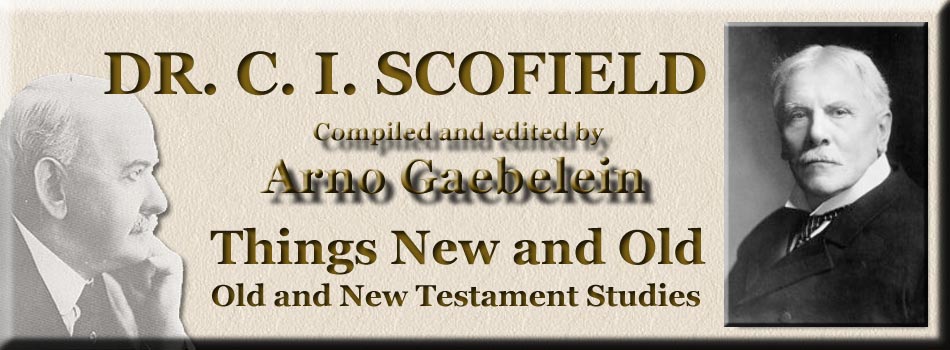
Things New and Old
By Cyrus Ingerson Scofield
Compiled and Edited By Arno Clement Gaebelein
THE TRANSFIGURATION.(Mark ix:1-13.) I. The Analysis. 1. The fulfillment of a promise (verses 1-7).—The Lord had promised that some standing with Him should not taste death till they had seen the kingdom. Verses 1-7 record the fulfillment of that promise. The transfiguration scene was not only a prophecy in action of the kingdom in its future manifestation, but was the kingdom in all its essential elements. These are, first, a glorified Christ, the centre; secondly, glorified saints, represented by Moses and Elijah, one of whom entered the glory through death, the other through rapture (1 Thess. iv:14-17); and living saints in their natural bodies on the earth, represented by Peter, James and John. When all was thus arranged, the Father's voice was heard over all. 2. Peter forgets the great law of the Christian life (verses 5, 6).—It was so "good" to be in that great scene that Peter quite forgot the multitude at the foot of the mountain (verse 14), and even the less privileged disciples. 3. Jesus completes and supplants the law of the prophets (verses 7-9). (See below.) II. The Heart of the Lesson. Peter had fallen into a twofold error—he had put Moses and Elijah on the same plane with Jesus, and he had forgotten both the less privileged disciples and the unsaved multitudes at the foot of the mountain (verses 14-29). Down there was a powerless church and an afflicted world. Moses was, indeed, "faithful in all his house as a servant," but "Christ as a Son, over His own house." And Christ was as immeasurably out of comparison with Moses as God ever is and ever must be out of such comparison (Heb. iii:3-6). Both mistakes were quickly corrected. Moses and Elijah disappeared, and they saw "no man any more save Jesus only"; and He led them down from the mount of vision into the sore need of the earth below. And that is the true use of vision. Moses, indeed, might have taught Peter that, for he had once been forty days in the glory studying "the patterns of the things in the heavens," only that he might come down again and reproduce them on the earth: "For see, saith he, that thou make all these things according to the pattern showed to thee in the mount." If the servant of God is privileged to "mount up with wings as eagles," it is only that, renewed in faith, and with vision purified, he may "run and not be weary, and walk and not faint" (Isa. xl:31). It is interesting to note that, largely, Peter's folly was due to a supposed necessity for saying something: "For he wist not what to say." Doubtless, then, he should have said nothing. Possibly many a church service would be quite wonderfully fruitful if the minister should humbly say: "Brethren, I have no message from God this morning. Whether it be your fault or mine I know not, but this I do know, that I have no message from Him." But these are, after all, gleanings from the surface of this lesson; the lesson of the lesson is that in Jesus is the consummation of all the counsels of God, and that neither the church nor the world needs any "man any more save Jesus only." In Him dwells "all the fulness of the Godhead bodily"; and in Him are "hid all the treasures of wisdom and knowledge" (Col. iirg, 3). It is "Jesus only" for salvation. There is "none other name under heaven given among men whereby we must be saved"; and upon finding the right answer to Pilate's question: "What shall I do then with Jesus who is called Christ," depends the eternal destiny of every human being to whom the offer of God's mercy in Christ Jesus is made. Even after nineteen hundred years of Gospel preaching it is still but dimly apprehended that Jesus Christ is God's only open proposition to the world. The age of law is past, and the sentence of the law rests upon every human being who is out of Christ. God is no longer saying: "If ye will enter into life, keep the commandments," but, "Believe on the Lord Jesus Christ and thou shalt be saved." And it is not only Jesus for salvation, but "Jesus only." Nothing, absolutely nothing but faith in Him is either required of the sinner or accepted of God. It is "Jesus only" for sanctification. ''Beholding as in a mirror the glory of the Lord, we are changed into the same image from glory to glory." True it is by "the Lord the Spirit," but the Spirit effects the wonderful transformation simply by showing us His glory (John xvi:14), and at last the final consummation of sanctification will be brought by the vision of "Jesus only," when we shall "see Him as He is" (1 John iii:2). It is "Jesus only" for whom we watch and wait. Having "turned to God from idols to serve the living and the true God," the believer waits, not for death, still less for judgment, but "for his Son from heaven" (1 Thess. i:9, 10).
|
|
 |
 |
|
|
|
-
Site Navigation
 Home
Home What's New
What's New Bible
Bible Photos
Photos Hiking
Hiking E-Books
E-Books Genealogy
Genealogy Profile
Free Plug-ins You May Need
Profile
Free Plug-ins You May Need
 Get Java
Get Java.png) Get Flash
Get Flash Get 7-Zip
Get 7-Zip Get Acrobat Reader
Get Acrobat Reader Get TheWORD
Get TheWORD